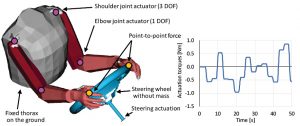
This study presents a novel method of modeling and simulating human driver-vehicle interaction to investigate the effects of automated driving systems (ADS) on driving performance and physical workload of human drivers. A framework of human model-based active driving systems (HuMADS) is introduced to simulate the interactive effects of active human driver motions and ADS actuation on steering maneuvers during a vehicle overtaking task. We model two modes of relaxed and tense human drivers, and model various ADS driving modes and levels of autonomy. The tense and relaxed human driver models perform the overtaking task with 0.25 and 0.35 m of lateral vehicle position error, respectively. However, ADS steering assistance reduces this error for the relaxed driver model to 0.25 m or less. On the other hand, the simulation results indicate difference of driving strategy between human driver and ADS affect reaction forces on the hand-steering wheel and human control workloads. For example, relaxed driver co-driving with ADS shows only 4.2 N of hand reaction force, while the tense driver under an overtaking task with ADS of running straight has 21.5 N of hand reaction force.
Publication
- Hideyuki Kimpara, Kenechukwu Mbanisi, Zhi Li, Danil Prokhorov, and Michael Gennert, “Human Model-based Evaluation of Overtaking Performance and Driver Control Workloads”, submitted to IEEE Transactions on Human-Machine Systems.

